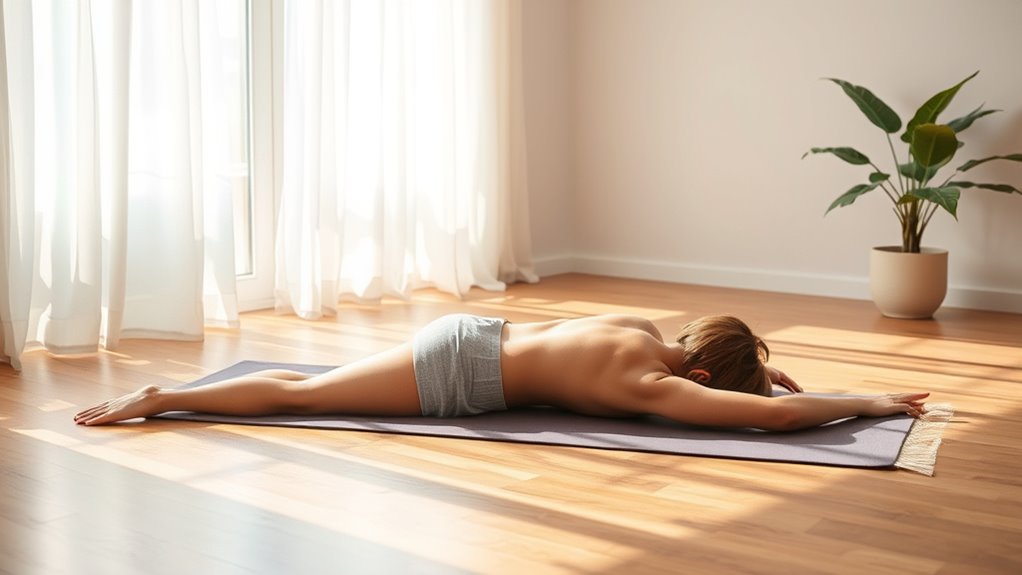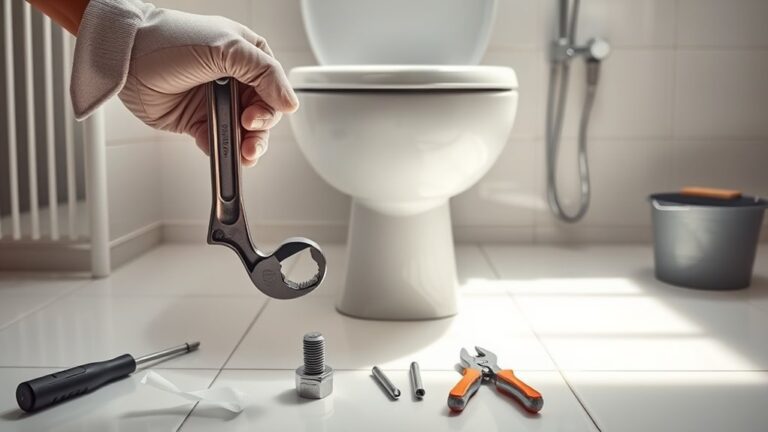Yes, lying on the floor can help ease your back pain by providing firm, even support that encourages proper spinal alignment and reduces muscle tension. This position helps relax tight muscles that often worsen discomfort. However, it’s important to maintain a neutral spine and limit your time to avoid added pressure. While floor lying offers relief for many, it’s just one approach among several you might explore. You can find out more about safe practices and alternatives ahead.
Understanding Common Causes of Back Pain
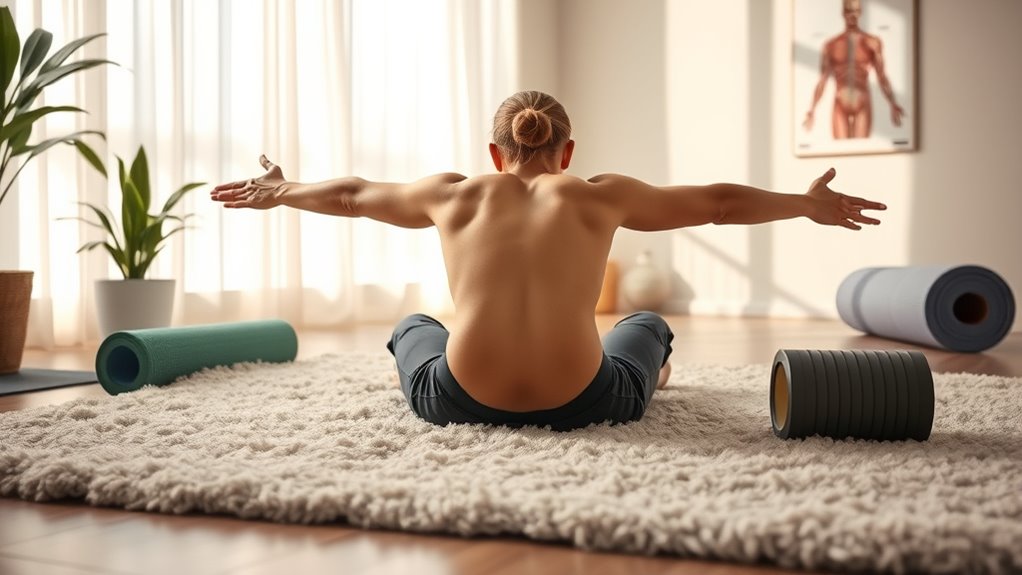
While back pain can affect anyone at any age, understanding its common causes is essential to finding effective relief. You might be dealing with muscle strain, often from overuse or sudden movements, which can cause sharp discomfort and limit your freedom of movement. Posture issues also play a notable role; poor alignment when sitting or standing puts undue stress on your spine and surrounding muscles. Recognizing these factors empowers you to take control—correcting posture and avoiding activities that strain muscles can prevent pain from worsening. By addressing these root causes, you’re not just managing symptoms but reclaiming your mobility and comfort. Remember, evidence supports that proactive adjustments in daily habits can meaningfully reduce back pain and enhance your overall well-being.
How Lying on the Floor Affects Spinal Alignment
Because your spine naturally curves in specific ways, lying on the floor can help you reset its alignment by providing firm, even support that encourages proper posture. When you lie flat, the floor support helps maintain the natural spinal curvature without the sinking or uneven pressure that soft mattresses might cause. This can reduce stress on your vertebrae and discs, promoting a more neutral spine position. However, it’s important to listen to your body—lying on the floor isn’t a cure-all but a tool to help guide your spine back into alignment. Start slowly, giving yourself time to adjust, and consider adding a thin pillow under your knees if that eases discomfort. This approach supports your back’s natural structure, helping you move toward greater freedom from pain.
The Role of Muscle Relaxation in Pain Relief
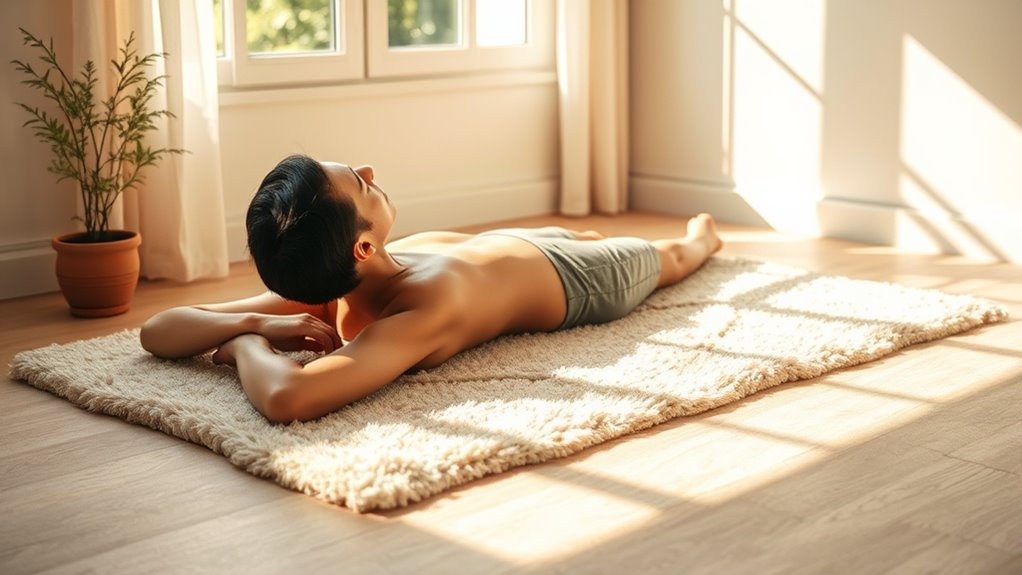
If your muscles remain tense, they can pull on your spine and surrounding structures, intensifying back pain. Muscle tension often creates a cycle where pain leads to more tightness, limiting your freedom of movement. Relaxation techniques, such as deep breathing, progressive muscle relaxation, or gentle stretching, can help break this cycle by easing muscle tightness and promoting blood flow. When you consciously relax your muscles, you reduce strain on your spine, which may lead to noticeable pain relief. Incorporating these techniques into your routine empowers you to take control of your discomfort. Remember, consistent practice is key—regular muscle relaxation supports your back’s natural alignment and helps you regain the freedom to move without pain holding you back.
Scientific Studies on Floor Lying and Back Pain
Although it may seem simple, lying on the floor has been studied for its potential benefits in alleviating back pain. Research shows that floor based exercises can improve spinal alignment and reduce muscle tension, key factors in effective pain management techniques. When you lie on a firm surface, it encourages natural posture, which some studies suggest helps ease discomfort. However, results vary depending on individual conditions, so it’s important to approach floor lying as a complementary method rather than a standalone solution. You might find relief by combining floor lying with other evidence-based practices. Always listen to your body and consult healthcare professionals to tailor pain management techniques that support your journey toward greater freedom and movement without pain.
Potential Benefits of Floor Lying for Back Pain
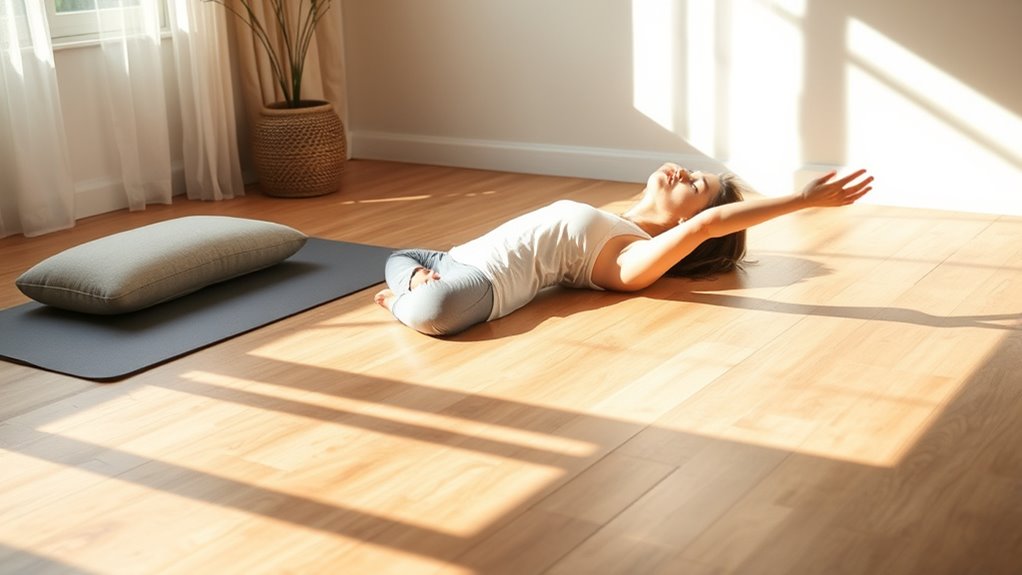
When you lie on the floor, it can help support proper spinal alignment, which may reduce pressure on your back. This position also encourages muscle relaxation, easing tension that often contributes to pain. Understanding these benefits can guide you in using floor lying as a simple, effective part of your pain relief routine.
Spinal Alignment Support
Because your spine plays an essential role in supporting your body, maintaining proper alignment is crucial for alleviating back pain. Lying on the floor can act as a simple spinal decompression technique, allowing gravity to gently stretch and realign your vertebrae. This position encourages natural posture correction exercises by providing a firm, even surface that helps you become more aware of your spinal alignment. When you lie flat, you reduce unnatural curves that often worsen discomfort. While it’s not a cure-all, incorporating floor lying into your routine can complement other methods to free you from pain’s grip. Remember, consistency matters—use this technique alongside professional advice to regain your back’s freedom and support your body’s natural structure.
Muscle Relaxation Effects
Along with supporting spinal alignment, lying on the floor can help your muscles relax by reducing tension and encouraging a natural release of tightness. When you lie flat, your muscles aren’t forced to compensate for uneven surfaces, which often causes muscle tension. This position allows your body to engage in simple relaxation techniques, promoting blood flow and calming the nervous system. You don’t need complex exercises—just a few minutes on the floor can ease muscle stiffness and improve your overall comfort. If you combine this practice with mindful breathing or gentle stretching, you enhance the relaxation effect, helping your back feel freer and less restricted. Remember, easing muscle tension is key to attaining lasting back pain relief and regaining your freedom of movement.
Risks and Drawbacks of Lying Flat on the Floor
Although lying flat on the floor can offer temporary relief for some people with back pain, it’s important to understand the potential risks and drawbacks before making it a regular habit. You might experience floor discomfort, especially if you have sensitive joints or limited cushioning. Prolonged time on a hard surface can aggravate pressure points, worsening pain instead of easing it. Certain risk factors, like existing spinal conditions or poor posture, may make lying flat less beneficial or even harmful. Without proper support, your back muscles might tense up, reducing the intended relaxation effect. Being aware of these risks empowers you to make informed choices about your back care, helping you seek freedom from pain without unintentionally causing more harm.
Alternative Positions to Relieve Back Pain
You might find that lying on the floor offers unique benefits for your back by providing firm support and encouraging proper alignment. Comparing this to resting on a bed can help you identify which surface eases your pain more effectively. Additionally, exploring other positions like lying on your side with a pillow between your knees could further reduce discomfort.
Benefits of Floor Lying
When you lie on the floor, your spine gets a chance to realign naturally, which can ease pressure on your discs and muscles. Floor lying encourages posture improvement by promoting neutral alignment without extra support. This simple shift can be freeing, letting you reconnect with your body’s natural position. Here’s what you might experience:
- Reduced lower back tension
- Enhanced spinal alignment
- Improved core muscle engagement
- Decreased muscle stiffness
- Greater awareness of posture habits
Comparing Floor and Bed
Lying on the floor offers unique benefits for spinal alignment, but comparing it to resting in bed helps you understand which position might better suit your back pain relief needs. The floor provides firm support that encourages natural posture, enhancing floor comfort for some. Meanwhile, a bed offers cushioning and adjustable bed support, which can ease pressure points but sometimes compromises spinal alignment.
| Aspect | Floor | Bed |
|---|---|---|
| Firmness | Very firm, limits sinking | Varies, can be soft or firm |
| Spinal Alignment | Encourages neutral spine | May cause sinking or sagging |
| Pressure Relief | Minimal cushioning | Provides cushioning |
| Comfort Level | May feel hard initially | Often perceived as more comfy |
| Adjustability | None | Adjustable bases available |
Choose what fits your body’s need for freedom and relief.
Other Effective Positions
Although no single position works perfectly for everyone, exploring alternative postures can greatly ease back pain by reducing pressure on spinal structures and supporting proper alignment. You can find relief by experimenting with these positions:
- Reclining with knees bent and feet flat to reduce lumbar strain
- Side-lying with a pillow between knees to maintain hip alignment
- Using ergonomic chairs that support natural spinal curves during sitting
- Gentle yoga stretches focusing on spinal mobility and core strength
- Standing with one foot elevated on a low stool to relieve lower back tension
These positions can help you regain freedom from discomfort by promoting balance and reducing stress on your back. Remember, consistency and mindful adjustments make a big difference in long-term relief.
When to Seek Professional Medical Advice
Since back pain is common and often resolves on its own, you might wonder when it’s necessary to see a healthcare professional. It’s important to seek medical advice if you experience red flags like severe trauma, numbness, weakness, or loss of bladder or bowel control. These symptoms could indicate serious conditions requiring prompt attention. Also, if your pain persists beyond 12 weeks or greatly limits your daily activities, it’s considered chronic pain and warrants evaluation. Don’t hesitate to reach out if your pain worsens or if self-care methods, including lying on the floor, don’t bring relief. Consulting a professional can free you from uncertainty and guide you toward effective treatments tailored to your needs, ensuring your journey to back health is safe and informed.
Tips for Using Floor Lying Safely and Effectively
How can you use floor lying to ease your back pain without causing further discomfort? Start by integrating floor exercises that promote gentle stretching and support spinal alignment. Remember, proper breathing is key—it helps relax your muscles and enhances oxygen flow, reducing tension.
Use floor lying with gentle stretches and deep breathing to ease back pain and support spinal alignment.
Here are tips to make floor lying safe and effective:
- Choose a firm, supportive surface to avoid sinking or strain
- Use a thin cushion or towel under your lower back if needed
- Maintain a neutral spine position to prevent added pressure
- Practice slow, deep breathing to stay relaxed throughout
- Limit sessions to 10-15 minutes, gradually increasing as tolerated

